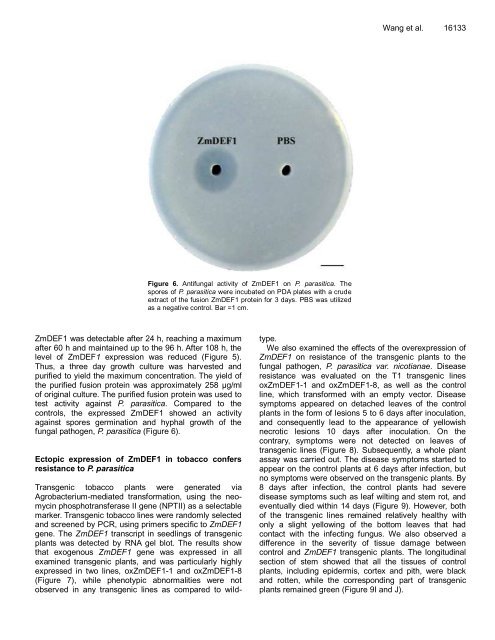(L.) C. Jeffrey from India using internal transcribed - Academic ...
(L.) C. Jeffrey from India using internal transcribed - Academic ...
(L.) C. Jeffrey from India using internal transcribed - Academic ...
Create successful ePaper yourself
Turn your PDF publications into a flip-book with our unique Google optimized e-Paper software.
ZmDEF1 was detectable after 24 h, reaching a maximum<br />
after 60 h and maintained up to the 96 h. After 108 h, the<br />
level of ZmDEF1 expression was reduced (Figure 5).<br />
Thus, a three day growth culture was harvested and<br />
purified to yield the maximum concentration. The yield of<br />
the purified fusion protein was approximately 258 μg/ml<br />
of original culture. The purified fusion protein was used to<br />
test activity against P. parasitica. Compared to the<br />
controls, the expressed ZmDEF1 showed an activity<br />
against spores germination and hyphal growth of the<br />
fungal pathogen, P. parasitica (Figure 6).<br />
Ectopic expression of ZmDEF1 in tobacco confers<br />
resistance to P. parasitica<br />
Transgenic tobacco plants were generated via<br />
Agrobacterium-mediated transformation, <strong>using</strong> the neomycin<br />
phosphotransferase II gene (NPTII) as a selectable<br />
marker. Transgenic tobacco lines were randomly selected<br />
and screened by PCR, <strong>using</strong> primers specific to ZmDEF1<br />
gene. The ZmDEF1 transcript in seedlings of transgenic<br />
plants was detected by RNA gel blot. The results show<br />
that exogenous ZmDEF1 gene was expressed in all<br />
examined transgenic plants, and was particularly highly<br />
expressed in two lines, oxZmDEF1-1 and oxZmDEF1-8<br />
(Figure 7), while phenotypic abnormalities were not<br />
observed in any transgenic lines as compared to wild-<br />
Figure 6. Antifungal activity of ZmDEF1 on P. parasitica. The<br />
spores of P. parasitica were incubated on PDA plates with a crude<br />
extract of the fusion ZmDEF1 protein for 3 days. PBS was utilized<br />
as a negative control. Bar =1 cm.<br />
Wang et al. 16133<br />
type.<br />
We also examined the effects of the overexpression of<br />
ZmDEF1 on resistance of the transgenic plants to the<br />
fungal pathogen, P. parasitica var. nicotianae. Disease<br />
resistance was evaluated on the T1 transgenic lines<br />
oxZmDEF1-1 and oxZmDEF1-8, as well as the control<br />
line, which transformed with an empty vector. Disease<br />
symptoms appeared on detached leaves of the control<br />
plants in the form of lesions 5 to 6 days after inoculation,<br />
and consequently lead to the appearance of yellowish<br />
necrotic lesions 10 days after inoculation. On the<br />
contrary, symptoms were not detected on leaves of<br />
transgenic lines (Figure 8). Subsequently, a whole plant<br />
assay was carried out. The disease symptoms started to<br />
appear on the control plants at 6 days after infection, but<br />
no symptoms were observed on the transgenic plants. By<br />
8 days after infection, the control plants had severe<br />
disease symptoms such as leaf wilting and stem rot, and<br />
eventually died within 14 days (Figure 9). However, both<br />
of the transgenic lines remained relatively healthy with<br />
only a slight yellowing of the bottom leaves that had<br />
contact with the infecting fungus. We also observed a<br />
difference in the severity of tissue damage between<br />
control and ZmDEF1 transgenic plants. The longitudinal<br />
section of stem showed that all the tissues of control<br />
plants, including epidermis, cortex and pith, were black<br />
and rotten, while the corresponding part of transgenic<br />
plants remained green (Figure 9I and J).

















